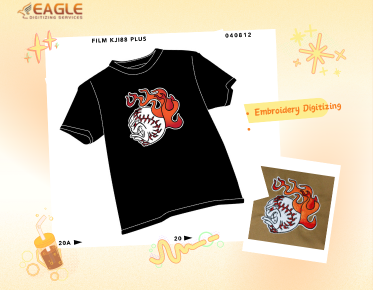Things You Need to Know When Digitizing Logos for Embroidery
In the realm of embroidery, digitizing is not just a technical step; it's a transformative process that breathes life into your logo. This transformation enables intricate designs to be stitched flawlessly onto fabric, ensuring that every curve and color resonates with your brand’s identity. Without proper digitization, a logo may lose its essence, muddling the message you wish to convey.
Understanding the Basics of Embroidery Digitization
At its core, embroidery digitization is the art of converting an image into a format that embroidery machines can interpret. This involves translating visual elements into a sequence of stitches that accurately reproduce the original design. Mastering this process is crucial for achieving high-quality results that stand the test of time.
Choosing the Right Online Digitizing Service
Key Factors to Consider When Selecting a Service
When selecting an online digitizing service, consider several key factors. Look for services that prioritize quality and have a solid reputation. Reviews and portfolios can offer insight into their capabilities. Additionally, customer support is vital—prompt communication can make a significant difference, especially if adjustments are needed.
Comparing Quality, Pricing, and Turnaround Times
Quality should always take precedence over pricing. While a budget-friendly option is tempting, it might compromise the integrity of your design. Weigh the cost against the quality of work and turnaround times. A reliable service will provide transparent pricing structures and realistic timelines, ensuring your project runs smoothly.
Understanding File Formats: What You Need to Know
Common File Formats for Embroidery: PES, DST, and More
Familiarizing yourself with common file formats is essential. PES, DST, and EMB are some of the prevalent types used in the industry. Each format has its unique characteristics and compatibility with different embroidery machines. Understanding these nuances will help you choose the right format for your specific needs.
How to Choose the Right Format for Your Needs
When selecting a file format, consider the machine you’ll be using and the complexity of your logo. For instance, DST is widely accepted across many machines, making it a safe choice. Conversely, PES may offer more advanced features for certain designs. Ensure the format you choose aligns with your embroidery process.
Preparing Your Logo for Digitization
Ensuring High-Quality Source Files: Resolution and Clarity
The journey to successful digitization begins with high-quality source files. Ensure that your logo is crisp, clear, and at a high resolution. A poor-quality image can lead to inaccuracies in stitching, resulting in a subpar final product. Aim for vector files or high-resolution raster images to guarantee the best results.
Simplifying Complex Designs for Better Results
Complex logos can pose challenges in the digitization process. Simplifying these designs—by reducing unnecessary elements or focusing on key features—can yield better results. A streamlined design is more manageable for digitizers and produces clearer, more attractive embroidery.
Color Considerations in Digitization
Understanding Thread Color Matching
Color matching in embroidery is an art form. Thread colors may appear different once stitched onto fabric, influenced by factors like texture and lighting. It’s vital to choose a thread color palette that closely aligns with your brand colors, ensuring the final product embodies your intended look.
How to Choose a Color Palette for Embroidery
Selecting the right color palette involves understanding both your design and the medium. Limit your palette to avoid overwhelming the design, opting for complementary colors that enhance visibility. Consider using a color guide specific to embroidery threads to navigate the array of available options.
The Role of Stitch Types in Digitizing
Exploring Different Stitch Types: Satin, Fill, and Running
Embroidery offers a variety of stitch types, each serving a distinct purpose. Satin stitches create smooth, polished lines, ideal for logos with curves. Fill stitches add depth and texture, perfect for larger areas. Running stitches provide a delicate touch, often used for outlines or fine details. Understanding these options helps you make informed choices for your design.
How to Select the Right Stitch for Your Logo Design
Choosing the appropriate stitch type hinges on your logo’s design characteristics. For logos with intricate details, satin stitches may be preferable for their precision. Larger logos can benefit from fill stitches, adding richness and vibrancy. Assess the overall aesthetic of your logo to guide your stitch selection.
Adjusting Size and Scale for Embroidery
How Size Affects Detail and Readability
Size plays a pivotal role in embroidery. Smaller logos may lose essential details, while larger designs can overwhelm the viewer. It’s crucial to find a size that retains the logo’s integrity while ensuring clarity. Testing different sizes during the digitization process will provide valuable insight into what works best.
Tips for Resizing Your Logo for Different Applications
When resizing your logo, maintain its proportions to avoid distortion. Consider how the logo will be used—whether on apparel, promotional materials, or signage. Each application may require a different size, so be prepared to adjust accordingly while keeping the essence of your brand intact.
Creating a Digitizing Plan: Step-by-Step Guide
Outlining Your Design Objectives
Before diving into digitization, outline your design objectives. Define the key elements you want to highlight, such as color, texture, and overall style. Having a clear vision will guide the digitization process, ensuring your final product aligns with your expectations.
Planning the Order of Operations in Digitization
A well-structured plan is crucial for smooth digitization. Determine the sequence in which elements will be stitched. This helps prevent complications during the embroidery process, ensuring that each part of your design is executed in harmony.
Testing Your Digitized Logo
The Importance of Sample Stitches: What to Look For
Sample stitches are a critical step in the digitization process. They provide a tangible representation of your logo and reveal potential issues. Look for clarity in details, proper stitch density, and overall aesthetic appeal. This phase is your opportunity to make necessary adjustments before finalizing the design.
Adjusting Based on Test Results: Learning and Improving
Reviewing the results of your sample stitches allows for growth. If certain areas don’t meet expectations, adjust the design or stitching parameters. This iterative process enhances the quality of the final product, ensuring it aligns with your vision.
Common Mistakes to Avoid When Digitizing
Overcomplicating Designs: When Less is More
One of the most common pitfalls is overcomplicating designs. While it’s tempting to include every detail, simpler designs often yield better results in embroidery. Focus on key elements that communicate your brand message effectively, avoiding unnecessary complexity.
Ignoring Fabric Type: Choosing the Right Approach
Fabric type plays a significant role in the digitization process. Different fabrics react differently to stitches and colors. Always consider the fabric you’ll be using, adjusting your approach to suit its characteristics. This ensures that your final product is both beautiful and durable.
Exploring Customization Options
Personalizing Your Design: Adding Unique Touches
Customization can elevate your logo to new heights. Consider adding unique touches, such as personalized elements or variations in stitch patterns. These enhancements can create a distinctive identity that sets your brand apart.
How to Incorporate Text and Taglines Effectively
Incorporating text into your logo design requires careful consideration. Choose fonts that align with your brand’s personality and ensure they remain legible when embroidered. Striking the right balance between text and imagery is essential for a cohesive design.
Maintaining Brand Consistency in Digitization
Ensuring Your Logo Reflects Your Brand Identity
Your logo is a representation of your brand identity. Ensure that every aspect of the digitized logo aligns with your brand’s values and aesthetics. This consistency will resonate with your audience, reinforcing your brand's message.
Color and Font Consistency Across Different Applications
Maintaining consistency across various applications is vital. Ensure that colors and fonts remain uniform, regardless of where the logo is used. This cohesive approach strengthens brand recognition and establishes a professional appearance.
Dealing with Complex Logos
Strategies for Simplifying Detailed Designs
Complex logos can be daunting, but simplifying them is achievable. Break down intricate designs into manageable parts, focusing on essential elements. This approach not only aids the digitization process but also results in a cleaner, more effective final product.
How to Break Down Complex Logos into Manageable Parts
Dissecting complex logos involves identifying key components and reimagining them for embroidery. Consider which elements are necessary and which can be omitted or simplified. This strategic breakdown will facilitate a smoother digitization process and improve the logo's overall clarity.
Stitch Density and Its Impact
Understanding Stitch Density: What It Is and Why It Matters
Stitch density refers to the number of stitches packed into a given area. It directly influences the appearance and durability of the embroidery. A higher density can create a richer, more textured look but may also lead to stiffness. Conversely, lower density provides flexibility but may lack detail. Finding the right balance is essential.
How to Adjust Density for Different Fabrics and Designs
Adjusting stitch density is crucial based on fabric type and design. Heavier fabrics may require higher density for durability, while lighter fabrics benefit from a more moderate approach. Experimenting with density settings during testing will help achieve optimal results.
Choosing the Right Thread Type for Your Logo
The Difference Between Polyester and Rayon Threads
Thread choice is pivotal in embroidery. Polyester threads are durable and colorfast, making them suitable for a variety of applications. Rayon threads, on the other hand, offer a luxurious sheen but may require more care. Understanding the differences allows you to select the best thread for your specific logo.
How Thread Choice Affects the Final Appearance
The thread you choose can dramatically impact the final appearance of your logo. Polyester threads provide vibrant colors and resilience, while rayon threads deliver a rich, glossy finish. Carefully consider the visual effect you want to achieve when selecting your thread.
Evaluating the Final Product
What to Look for in the Finished Embroidery
Once the embroidery is complete, evaluate it meticulously. Look for clarity in details, accurate color representation, and overall quality. The final product should embody your brand’s identity and meet your expectations.
Ensuring Quality Control Before Approval
Quality control is essential before approving the final product. Review every aspect of the embroidery, ensuring it meets the established criteria. This attention to detail will prevent potential issues down the line and uphold your brand's reputation.
Embarking on the journey of digitizing a logo is both exciting and challenging. By understanding the nuances of the embroidery digitization process and making informed choices, you can create a final product that truly reflects your brand. Embrace the opportunity to experiment and innovate, allowing your logo to shine in every stitch.
.png)


